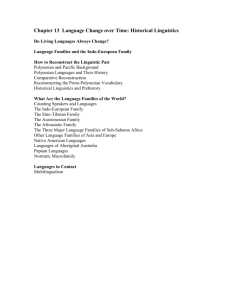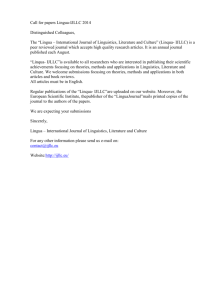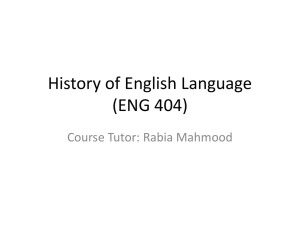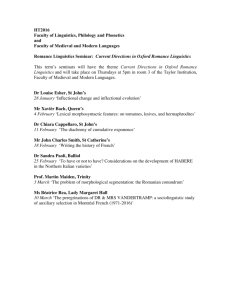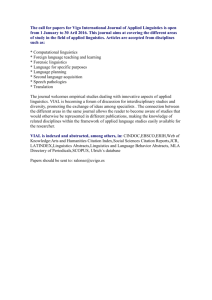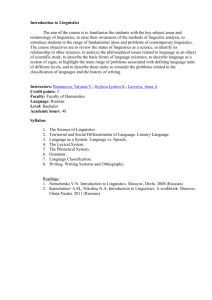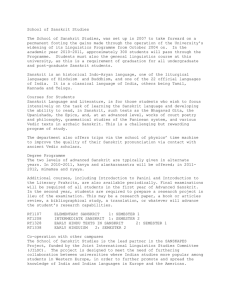Language History & Change: Linguistics Presentation
advertisement
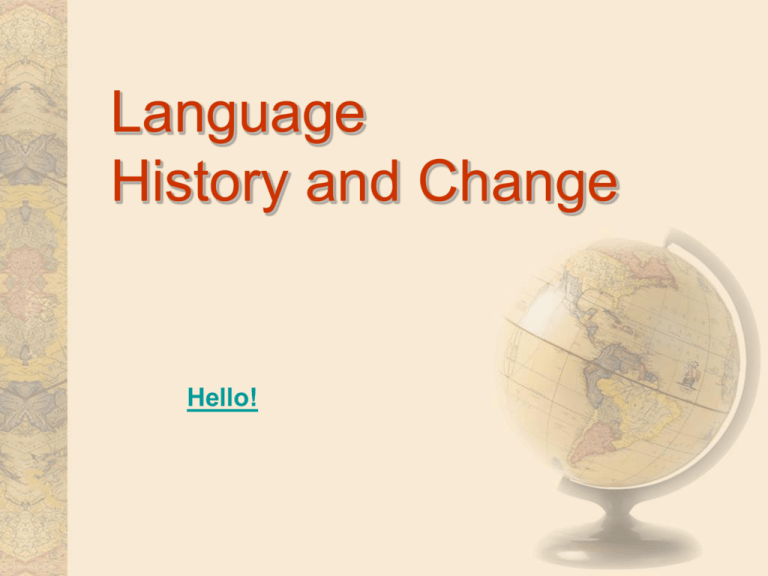
Language History and Change Hello! Some Definitions SUBFIELDS OF LINGUISTICS –Historical linguistics (Ancestors of languages) –Comparative linguistics (Languages compared) –Diachronic Linguistics (single features of language are traced over time) –Synchronic Linguistics (language structure at a certain point in time) ANALYTICAL PROCESSES –Reconstruction of the ProtoLanguage –Comparative Method Incredibly Different or Incredibly Alike? • Martin Joos (1957): unlimited and unpredictable differences • Chomsky (1957): human speak a single language with many mutually unintelligible dialects. (The “Martian” view) The Tower of Babel Genesis 11:-1-9 Account Language Origins • Neanderthals – Anatomy allowed only limited range of sounds. • 5000 BCE – Oldest records of IndoEuropean Languages: Hittite, Snaskrit, ?Proto-Indo-European • 500 CE – Emergence of Romance, Germanic Languages (Old English) Proto-Language Theory • Sir William Jones (1786) - In India, observed commonalities among Sanskrit, European and Middle Eastern languages. (So many similarities can’t be the effect of chance) • Analogous to Darwin’s theories: thus became known as “The Family Tree” theory, formulated by A. Schleicher (1871). – “Languages change in regular, recognizable ways” – the comparative method. Sanskrit: a literary language of India SANSKRIT: a language of India (studied by Pānini, a Indian 4th century BC grammarian) Nostratic Hypothesis Nostratic Afro-Asiatic (Hebrew, Arabic, Berber…) Kartvelian (South Caucasian) Dravidian Eurasiatic Indo-European Celtic, Italic, Greek, Germanic, Balto-Slavic, Armenian, Albanian, Indo-Iranian, (Tocharian), Anatolian Uralic Altaic Source: The Atlas of Languages, 1996, London Genetic Families – Linguistic Tree Indo-European “Family Tree” Indo-European Spreading? Indo-European Spreading? The Comparative Method • August Schleicher (1821-68), German Linguist • Proto-Latin *ptr – Classical Greek: – Sanskrit: – Latin: • • • • • Italian: Spanish: French: Portuguese: Catalan: – Gothic: – Old Irish: patēr piter pater padre padre père pai pare fadar athir Wave Models • Difficulties with the “Family Tree” model: – Languages do not form uniform speech communities – Language “splits” are not sudden—they have many intermediate stages • Wave Model shows gradual and over-lapping relationships Neither model accounts for the evidence that languages can exhibit similarities without necessarily being related: pidgins & creoles, for example. Darwinian View • “Progress, therefore, is not an accident, but a necessity…It is part of nature” • “[in language] the better, the shorter, the easier forms are constantly gaining the upper hand, and they owe their success to their inherent virtue.” (Darwin 1871) Flaws of Darwinian View: (the “Survival of the Fittest”) • Implies that existing forms are better than old ones. • Confuses progress/decay with expansion/decline • Expansion/decline just reflects sociopolitical issues (not the intrinsic merit or decadence of language) • Counter examples in history: dominant languages in the world reflect conquering (political, economic, military, technological) powers, not “betterness” of those languages (Gaelic example)
